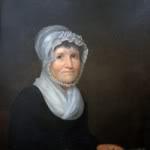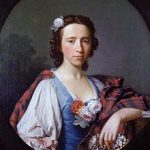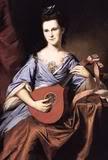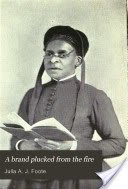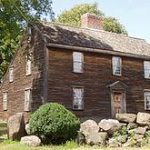Wife of Signer John Witherspoon
Image: John Witherspoon
John Witherspoon was born on February 5, 1722, at the village of Gifford, near Edinburgh, Scotland. The males in his family were all clergymen, and he was trained to become a Presbyterian minister. At the age of four, he could read the Bible. He attended grammar school at the neighboring town of Haddington. At age 13, he entered college, and earned Master of Arts (1739) and Doctorate of Divinity (1743) degrees from the University of Edinburgh.
In 1743, the Haddington Presbytery licensed him to preach, and he was ordained two years later at Beith, Ayrshire, as a Church of Scotland (Presbyterian) minister. He occupied that pulpit until 1757, and there he met Elizabeth Montgomery, a woman distinguished for her piety and benevolence
In 1746, Witherspoon helped to raise troops to fight Scottish rebels who were rebelling against the English domination in Scotland. The rebels captured him, imprisoned him in a castle, and threatened to kill him. Although he was released unharmed a few days later, he later had trouble sleeping, and would often faint in broad daylight.
Elizabeth Montgomery married John Witherspoon in 1748. His biographers say of her: “She was a Scotch woman of little education, but whose piety, benevolence, and graciousness made her beloved by all who knew her.” Elizabeth and John had ten children, five of whom died before they left Scotland; three sons and two daughters accompanied their parents to America.
James, the eldest, a young man of great promise graduated from Princeton in 1770, and joined the American army as an aide to General Francis Nash, with the rank of major. The next youngest son, John, graduated from Princeton in 1774, practiced medicine in South Carolina, and was lost at sea in 1795. David, the youngest son, graduated the same year as his brother, married General Nash’s widow, and practiced law in New Bern, North Carolina. Anna, the eldest daughter, married Reverend Samuel Smith, DD, who succeeded Dr. Witherspoon as President of Princeton. Frances, the youngest daughter, married Dr. David Ramsey, the historian of South Carolina.
John Witherspoon was offered the presidency of the College of New Jersey – now Princeton University – in 1766. He declined because of financial embarrassments, and the opposition of his wife, who did not wish to leave her family and friends and journey to a strange land. Elizabeth thought that to leave home “would be as a sentence of death to her.”
However, due to the influence of Richard Stockton and Benjamin Rush (both trustees of the college and fellow signers of the Declaration), Elizabeth agreed to accompany her husband to America. With their five surviving children, the Witherspoons reached Philadelphia in early August 1768. Witherspoon professed that he loved his new country, and that he had “become an American the moment he landed.”
When the Witherspoons moved on to Princeton a few days later, they were greeted a mile out of town by tutors and students, who escorted them to Morven, home of Richard Stockton. That evening the students celebrated the occasion by illuminating Nassau Hall on the campus with a lighted tallow dip in each window. Witherspoon was inaugurated as president of the college, and devoted himself to his new endeavor.
For the next 26 years, Dr. Witherspoon would serve as Princeton’s sixth President and head professor of the small Presbyterian college, helping to make it a great institution of higher learning. The College’s primary purpose at the time was training ministers, and Witherspoon became a major leader of the early Presbyterian Church in America. Of the several courses he taught, including Eloquence, Chronology (history), and Divinity, none was more important than Moral Philosophy, a required course, and one he considered vital for ministers, lawyers, and those holding positions in government (magistrates).
Witherspoon found the school in debt, instruction had become weak, and the library collection did not meet current student needs. He began fund-raising locally and back home in Scotland, and added 300 of his own books to the library. He was firm but good-humored in his leadership and instituted a number of reforms, including modeling the syllabus and university structure on that used at the University of St. Andrews and other Scottish universities. He purchased of scientific equipment, maps, and a globe. He also tightened up entrance requirements. These changes put the school more on par with Harvard and Yale. He was very popular among both faculty and students.
In his personal life, he was an affectionate husband, a tender parent, a kind master, and a sincere friend. To the day of his death, his speech revealed his Scottish birth. A man of medium height, tending toward stoutness, with bushy eyebrows, a prominent nose, and large ears, he had a quality contemporaries were inclined to describe as presence. One of his students, a later president of the College, recalled that Witherspoon had more presence than any other man he had known, except for General Washington.
Witherspoon lived at first in the President’s House (now called the John Maclean House), but after several years he moved about a mile north of the village to Tusculum, a handsome residence he built. His route to and from the College is indicated by the street that bears his name.
As a native Scotsman, long wary of the power of the British Crown, Dr. Witherspoon supported the Revolution early on, and joined the Committees of Correspondence and Safety in early 1774. He contributed to the cause of the Patriots by sermons and writings, and by participation in various local activities. His 1776 sermon, The Dominion of Providence over the Passions of Men was published in many editions.
On June 22, 1776, after taking part as a member of the Provincial Congress in overthrowing the authority of the royal governor, William Franklin, Witherspoon was elected to the Continental Congress as part of the New Jersey delegation. He took his seat a few days before the fourth of July, and actively participated in the deliberations on the momentous question of independence. Despite his Scottish accent, he astonished the whole house by the arrangement of his ideas, his command of the language, and his precision on subjects of importance.
He was impatient with the delay in passing the Declaration of Independence, stating that “he that will not respond to its accents, and strain every nerve to carry into effect its provisions, is unworthy of the name of freeman” and protesting for himself that “although these gray hairs must soon descend into the sepulcher, I would infinitely rather that they should descend thither by the hand of the public executioner than to desert at this crisis the sacred cause of my country.”
On July 2, 1776, Witherspoon voted for Richard Henry Lee’s Resolution for Independence, and it was adopted. In answer to an objection that the country was not yet ready for independence, he replied that it “was not only ripe for the measure, but in danger of rotting for the want of it.”
Image: John Witherspoon Signature
On the Declaration of Independence
On July 4, 1776, the Declaration of Independence lay on the table in Independence Hall in Philadelphia. Now the time was at hand when each delegate would put pen to paper, thus committing his life, his fortune, and his sacred honor to a future darkened by clouds of war. If their bid for liberty failed, those who signed would be the first to be hung from a British noose.
Sensing the urgency of the moment, John Witherspoon rose to speak:
There is a tide in the affairs of men, a nick of time. We perceive it now before us. To hesitate is to consent to our own slavery. That noble instrument upon your table, which ensures immortality to its author, should be subscribed this very morning by every pen in this house. He that will not respond to its accents and strain every nerve to carry into effect its provisions is unworthy the name of freeman.
For my own part, of property I have some, of reputation more. That reputation is staked, that property is pledged, on the issue of this contest; and although these gray hairs must soon descend into the sepulcher, I would infinitely rather that they descend thither by the hand of the executioner than desert at this crisis the sacred cause of my country.
Witherspoon’s words gave voice to the sentiments of the majority of delegates, and on July 4, 1776, America declared her independence. And on August 2, Witherspoon and most of his fellow delegates signed the Declaration of Independence.
Dr. Witherspoon served in Congress from June 1776 until November 1782, he became one of its most influential members, and was a frequent commuter between Princeton and Philadelphia. He served on more than 100 committees, most notably the powerful standing committees, the board of war, and the committee on secret correspondence or foreign affairs. His influence was such that he helped to educate a generation of leaders for the new nation.
Through the years he served in Congress, Witherspoon’s patriotism and judgment won the respect of his colleagues. In his philosophy of freedom, Witherspoon was one of the most consistent of the Founding Fathers. He never lost his belief that America would prevail in its fight for independence, wearing his minister’s robes in Congress to remind the delegates that God was on their side.
He struggled through these years – not always successfully – to keep the College in session. In November 1776 – five months after Witherspoon signed the Declaration – the British redcoats occupied the college’s major building, Nassau Hall, burned the library, and Witherspoon’s papers and personal notes were lost.
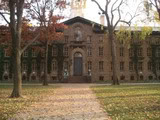
Image: Nassau Hall
Princeton University
The Battle of Princeton, fought in a nearby field in January 1777, proved to be a decisive victory for General George Washington and his troops, but the college was badly damaged when General Washington struggled to wrest the college from British control. The school was so badly damaged that it had to be closed for several years.
In Congress, Witherspoon spoke often in debate; helped draft the Articles of Confederation; helped organize the executive departments of the government; played a major role in shaping foreign policy; and drew up the instructions for the peace commissioners. Adopted by Congress on November 15, 1777, the Articles became operative on March 1, 1781, when the last of the thirteen states signed the document.
Witherspoon left the Continental Congress in November 1782 to rebuild his beloved Princeton, when the war was ended – a war that had cost him the life of his son James (who was killed in October 1777 at the Battle of Germantown) – and peace, with American independence, seemed assured. During the summer of 1783, the Continental Congress met in Nassau Hall, making Princeton the country’s capital for four months.
In 1783, he visited England with Joseph Reed, intending to promote Princeton College and request contributions, but he found the British so embittered toward the American people that he was able to raise little more than his expenses on the voyage.
Upon returning to the States in 1784, Witherspoon devoted most of his effort to rebuilding the college, which caused him great personal and financial difficulty. The school never fully recovered its prewar prosperity during his lifetime. The cultivation of his farm, Tusculum, might have offered some respite from his troubles.
Between 1783 and 1789, he sat for two terms in the New Jersey Legislature, and strongly supported the adoption of the United States Constitution during the ratification debates. New Jersey was the third state to ratify the Constitution.
But through these later years, too, Witherspoon remained remarkably active and influential. He contributed greatly to the organization of a newly independent and national Presbyterian Church, and in 1789 opened its first General Assembly with a sermon and presided until the election of the first moderator.
Elizabeth Montgomery Witherspoon died in 1789.
In 1791, the 68-year-old president delighted the college community by marrying the 24-year-old widow of Dr. Armstrong Dill of Philadelphia – Ann Dill – with whom he had two daughters.
Besides writing, Witherspoon spent his last years building up Princeton. But above all, the name he had earned as a divine, an educator, and a patriot brought prestige to the College, and he is rightly remembered as one of the great presidents of Princeton.
Witherspoon’s last years were filled with difficulty. Two accidents left him totally blind during the last two years of his life. The college’s finances were in disarray, and through these later years, his son-in-law, Samuel Stanhope Smith, increasingly carried the responsibility of conducting the College’s affairs, and Smith succeeded Witherspoon as president of Princeton.
Dr. John Witherspoon died on November 15, 1794, at his farm, Tusculum, at the age of 71. He is buried in the Presidents’ Lot at Princeton Cemetery.
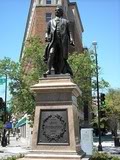
Image: Dr. John Witherspoon Statue
On Connecticut Avenue in Washington, DC
Legacy
Ideals that Witherspoon preached from the pulpit and ideas that he taught in the classroom lived on after his death. As to his legacy at Princeton, from among his students came 37 judges, three of whom made it to the US Supreme Court; 10 Cabinet officers; 12 members of the Continental Congress, 28 US senators and 49 US congressmen. One student, Aaron Burr, became Vice President, and James Madison became President. These men and many others had a tremendous influence on the young republic.
There is no soldier so undaunted as the pious man – no army so formidable as those who are superior to the fear of death. There is nothing more awful to think of than that those whose trade is war should… expose themselves to the imminent danger of being [sent] to the blaspheming rage and despairing horror of the infernal pit. Let therefore everyone who… offers himself as a champion in his country’s cause be persuaded to reverence the name and walk in the fear of the Prince of the kings of the earth and then he may with the most unshaken firmness expect [God’s protection] either in victory or death.
~John Witherspoon, addressing soldiers in the American Revolution
SOURCES
John Witherspoon, From Alexander Leitch, A Princeton Companion, copyright Princeton University Press (1978).
Princeton University
John Witherspoon 1723-1794
Wikipedia: John Witherspoon
Elizabeth Montgomery Witherspoon
John Witherspoon: Animated Son of Liberty

